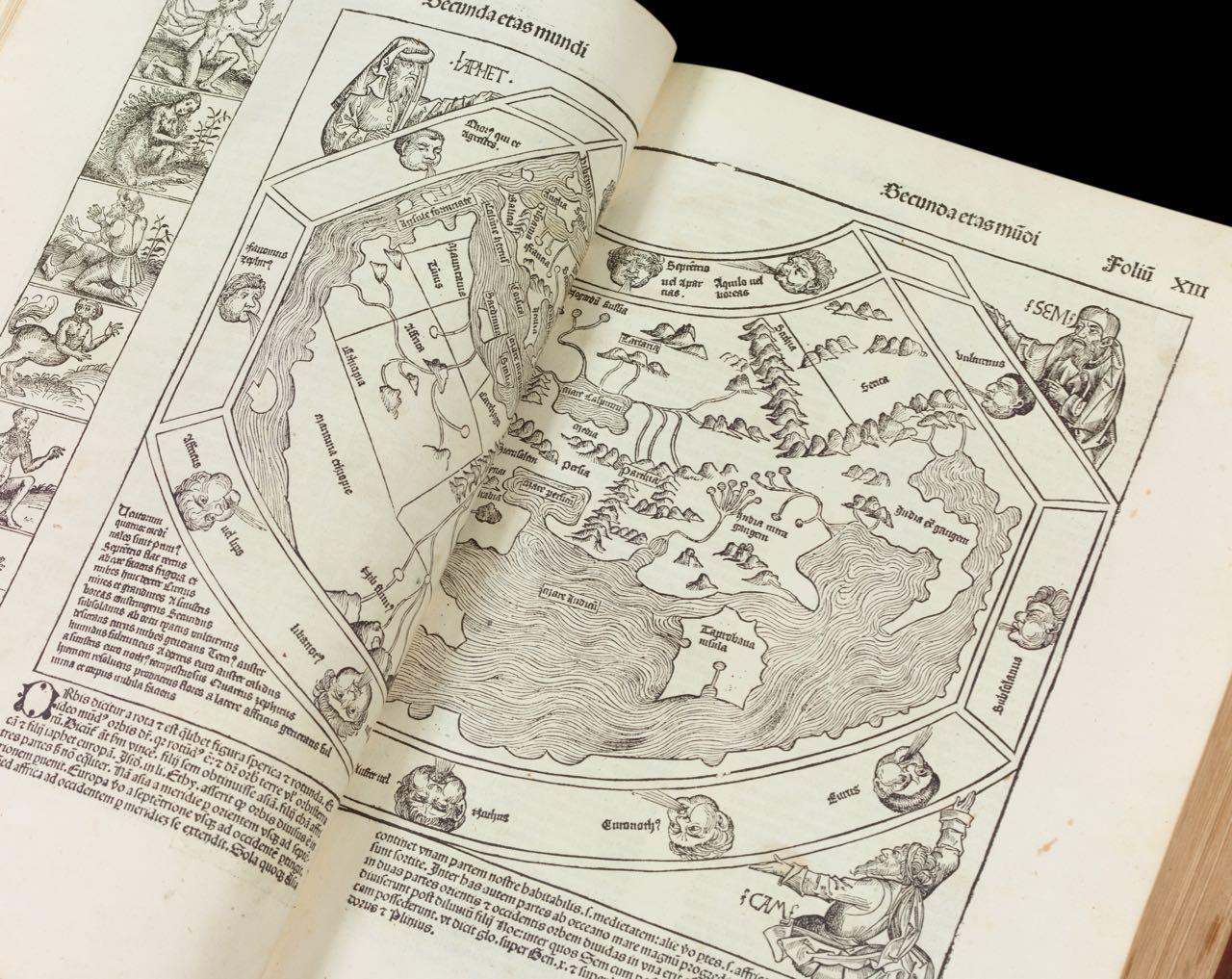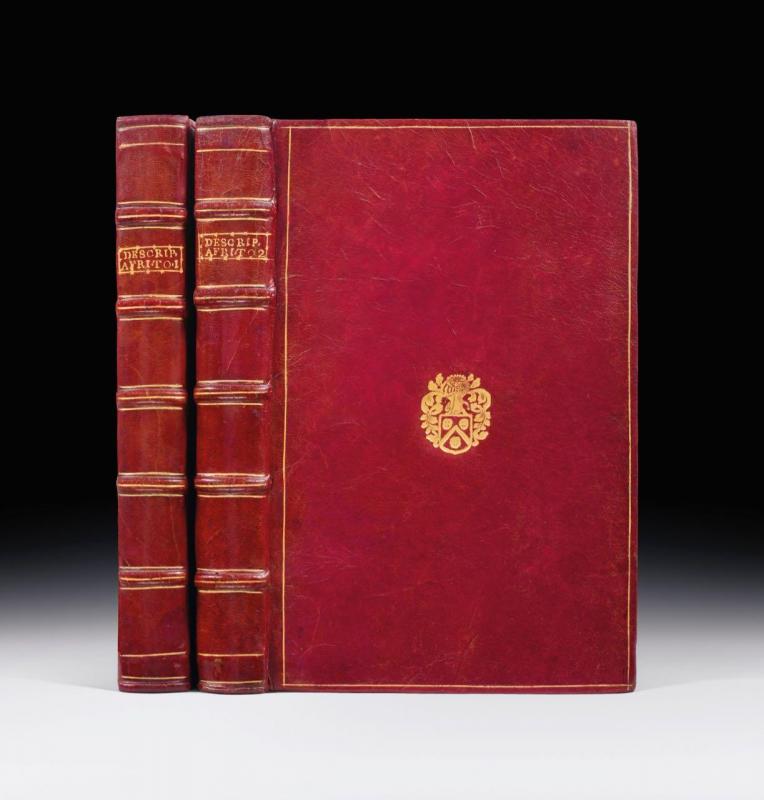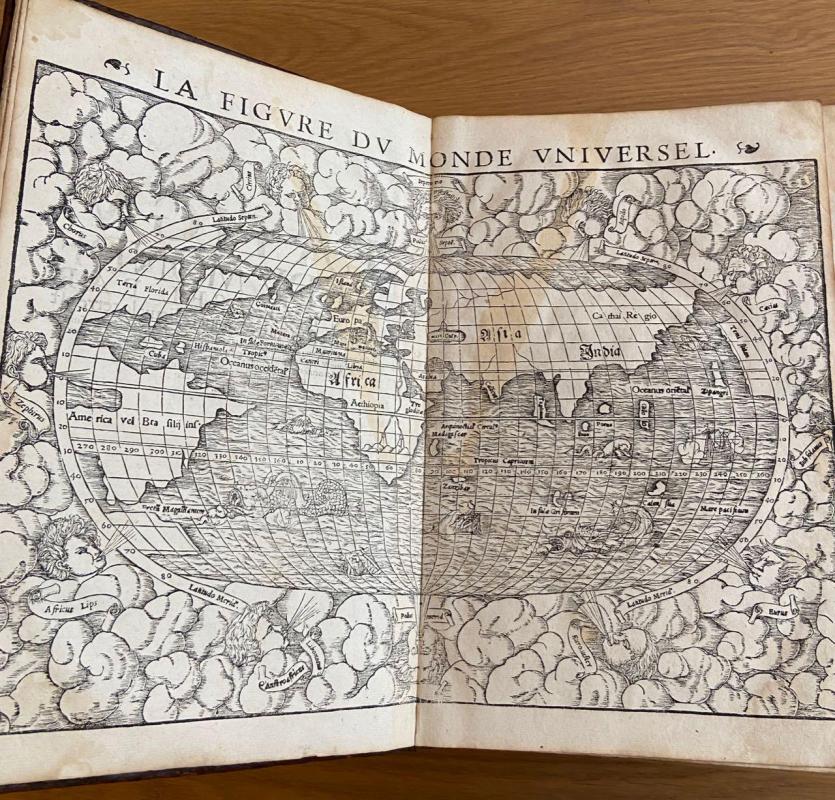Étienne MARCHAND. Voyage autour du monde


Le troisième circumnavigateur Français à avoir publié sa relation de voyage.
MARCHAND (Étienne).
& FLEURIEU (Charles-Pierre, Claret de), rédacteur.
Voyage autour du monde pendant les années 1790, 1791 et 1792, par Étienne Marchand, précédée d’une introduction historique ; auquel on a joint des recherches sur les terres australes de Drake, ornée de cartes et figures. Nouvelle édition.
Paris, Chez Th. Pitrat, Éditeur, 1841 [1798-1800].
4 tomes en 3 volumes in-4° ; XII-CXLIV-628 pp.-(2)-1 tableau h.-t. repliée ; XVI-676 pp.-(1) ; (2)-de la p. IV à la p. XI-431 pp.-(1) ; (2)-VIII-158 pp.-1 f. non chiffré [Avis au relieur]-16 cartes repliées in-fine [I-VI-VI bis-XV].
Une demi-basane vert Empire, dos lisse joliment orné, palette or, fleurons à froid, titre or, reliure de l’époque, un bel exemplaire.
Format bibliographique : 270 x 200 mm
8 000 €
BIBLIOGRAPHIE
Édition originale remise en vente en 1841 avec un titre de relais portant la mention fictive « Nouvelle Édition » (quelques exemplaires imprimés en 1798 n’avaient toujours pas trouvé acquéreur).
– Hill, 612. – Howgego, M43. – Lada-Mocarski, 54. – Sabin, 24751 & 44491. – Wickersham, A Bibliography of Alaskan Literature, 6622.
Un grand voyage
Relation du voyage du « Solide », rédigée par Claret de Fleurieu, alors ministre de la Marine. Fleurieu, qui ignorait l’existence du manuscrit du capitaine Marchand (cf. Introduction, p. CXXXVII), n’avait entre les mains que le journal de bord de Prosper Chanal, capitaine en second à bord du « Solide », auquel il ajouta, au cours de la rédaction, les précieuses observations du chirurgien-major Claude Roblet, premier officier de santé à bord.
Le navire fut armé à Marseille par une firme de riches marchands locaux – les J. et D. Baux – pour un voyage commercial dont le but était le commerce des pelleteries : le plan consistait à faire voile le plus vite possible vers la côte nord-ouest, de là obtenir une première cargaison de fourrures, puis traverser le Pacifique vers la Chine, où elles seraient revendues. Bénéfices faisant, derechef à la côte et traversée du Pacifique. À la troisième visite à Canton, Marchand devait acheter du thé, de la soie et d’autres marchandises originaires de Chine qu’il rapporterait en France.
Le « Solide » quitta Marseille le 14 décembre 1790. Il passa le détroit de Gibraltar le 29 décembre ; Tenerife fut apercue en janvier et les îles du Cap-Vert une semaine plus tard. Il s’ensuivit une longue étape (intentionnelle) de plus de dix mille milles vers les îles Marquises en doublant le cap Horn. Le 12 juin 1791, l’île de Madalena (Fatu-Hiva) fut en vue ; deux jours plus tard le « Solide » mouillait dans la baie de Madre de Dios, à Santa Christina (Tahuata). De nombreuses baies furent visitées et relevées. Le 24 juin, le navire mit à la voile en direction du Nord. Le 7 août, Marchand atteignit le cap El Engano et commença à trafiquer dans la baie de Norfolk. Il quitta la côte nord-ouest le 8 septembre. Début octobre il était en escale à Hawaii. Naviguant à travers les Mariannes du Nord puis vers le Sud, il arriva le 27 novembre à Macao où il apprit qu’un décret récemment promulgué interdisait l’entrée de toute peau dans le Sud de la Chine. Il quitta ce pays le 6 décembre. Le 30 janvier 1792, le « Solide » mouillait à l’Île-de-France. Le 18 avril, il fit voile vers la France où il arriva en août à Toulon. Le voyage n’avait duré que vingt mois. Ce fut l’une des plus rapides circumnavigations du XVIIIe siècle.
Nota Bene: L’ouvrage contient un glossaire de Vaitahu (Tahuata) et les analyses des voyages de Roberts, Hergest, Ingraham et Roggeween.
First edition re-issued in 1841 with a new title-page bearing the fictitious mention "New Edition" (some copies printed in 1798 had still not found a buyer). The third French circumnavigator to have published his travel report.
Bibliographic size : 270 x 200 mm
A great journey round the world. According to Lada-Mocarski, "a very important and authoritative work for the history of the Northwest coast". This is the narrative by Charles Claret de Fleurieu, then Minister of the French Navy, of the voyage of the Solide under the command of Etienne Marchand, the first French commercial voyage to the Northwest coast of America, and the third French circumnavigation.
The voyage of Étienne Marchand belongs to the European circumnavigations of the end of the 18th century. His route, inspired by the fur‑trade between Nootka Sound and Macao, was hardly original. The Solide was a private merchant vessel whose mission was strictly commercial. She sailed from Marseille in December 1790 and her return in August 1792 went unnoticed. The voyage, although a commercial fiasco, is noteworthy on account of its speed and the discovery, on a route where others had mostly gone before, of the northern group of the Marquesas Islands which he baptised the Isles of the Revolution.
Written by Claret de Fleurieu who was unaware of the existence of Captain Marchand's manuscript (cf. Introduction, p. CXXXVII), had only the logbook of Prosper Chanal, first mate on board the 'Solide', to which he added, during the writing, the valuable observations of Claude Roblet, surgeon on board.
The ship was fitted out in Marseilles by a firm of rich local merchants - the J. and D. Baux - for a commercial voyage whose purpose was the fur trade: the plan was to sail as quickly as possible to the north-west coast, from there to obtain a first cargo of furs, and then to cross the Pacific to China, where they would be sold. On the third visit to Canton, Marchand was to buy tea, silk and other goods from China to take back to France.
The "Solide" left Marseille on 14 December 1790. She passed the Straits of Gibraltar on 29 December; Tenerife was sighted in January and the Cape Verde Islands a week later. This was followed by a long (intentional) leg of more than ten thousand miles to the Marquesas Islands rounding Cape Horn. On 12 June 1791, the island of Madalena (Fatu-Hiva) was in sight; two days later the "Solide" anchored in the bay of Madre de Dios, in Santa Christina (Tahuata). Many bays were visited and surveyed. On 24 June, the ship set sail for the north. On 7 August, Marchand reached Cape El Engano and began to trade in Norfolk Bay. He left the northwest coast on 8 September. By early October he was on a stopover in Hawaii. Sailing through the Northern Marianas and then southwards, he arrived on 27 November in Macau where he learned that a recently issued decree forbade the entry of any skin or fur into southern China. He left that country on 6 December. On 30 January 1792, the "Solide" anchored at Île-de-France (Maurotius today). On 18 April, she sailed to France where she arrived in August at Toulon. The voyage had lasted only twenty months. It was one of the fastest circumnavigations of the 18th century.
Nota Bene : The book contains a glossary of Vaitahu (Tahuata) and analyses of the voyages of Roberts, Hergest, Ingraham and Roggeween.





